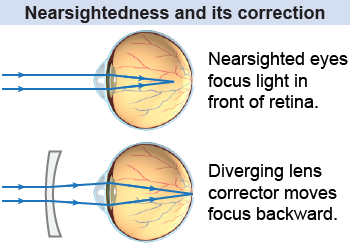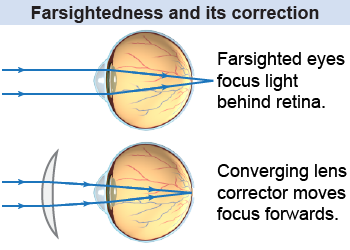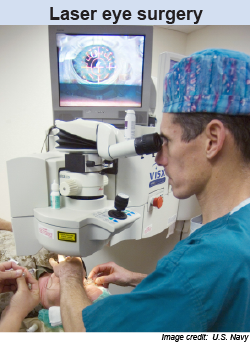|
Do you wear glasses or contact lenses? If so, then it is likely because your eyes do not always properly accommodate or change their focal length to focus images onto your retinas. The purpose of corrective lenses is to bend the path of incoming light so that the eye better focuses the light onto the retina. 
|
 A person whose eyes form an image in front of the retina has nearsightedness or myopia and can only focus well on objects that are located close to the eyeball. This condition can be caused either by the eyeball being longer than normal or by a cornea that has too much curvature. Nearsightedness can be corrected with diverging lenses. These eyeglasses spread apart light rays so that the eye will focus them further back and onto the retina.
A person whose eyes form an image in front of the retina has nearsightedness or myopia and can only focus well on objects that are located close to the eyeball. This condition can be caused either by the eyeball being longer than normal or by a cornea that has too much curvature. Nearsightedness can be corrected with diverging lenses. These eyeglasses spread apart light rays so that the eye will focus them further back and onto the retina. 
|
 A person whose eyes form an image behind the retina has farsightedness or hyperopia and can only focus well on more distant objects. This condition can be caused either by the eyeball being shorter than normal or by a cornea that has too little curvature. Farsightedness can be corrected with converging lenses. These eyeglasses bring light rays together so that the eye will focus them further forward and onto the retina.
A person whose eyes form an image behind the retina has farsightedness or hyperopia and can only focus well on more distant objects. This condition can be caused either by the eyeball being shorter than normal or by a cornea that has too little curvature. Farsightedness can be corrected with converging lenses. These eyeglasses bring light rays together so that the eye will focus them further forward and onto the retina. 
|
In some people the cornea is not round, but is instead flattened more like a cylindrical lens. A person with astigmatism will see images that are extended more in one direction than another because the light is focusing at different distances from the retina. This causes lines in one direction, such as horizontally, to be in focus while vertical lines are blurred. Astigmatism can be corrected with a cylindrical lens that compensates for the shape of the cornea. 
 |
 Some vision aberrations can be corrected by using laser treatments, such as the laser-assisted in situ keratomileusis (LASIK) procedure. An ophthalmologist uses laser surgery to make small changes in the shape of the cornea of the eye, thus changing the eye’s refractive properties (such as focal length). The doctor first uses a small metal blade (or laser) to cut a series of thin flaps on the cornea itself. The flaps are folded back and then an ultraviolet excimer laser is used to remove small amounts of tissue underneath, thereby subtly modifying the shape of the cornea. The flap is put back into position, where natural adhesion holds it in place. Laser eye surgery can provide a permanent correction for nearsightedness, farsightedness, or astigmatism as an alternative to eyeglasses or contact lenses.
Some vision aberrations can be corrected by using laser treatments, such as the laser-assisted in situ keratomileusis (LASIK) procedure. An ophthalmologist uses laser surgery to make small changes in the shape of the cornea of the eye, thus changing the eye’s refractive properties (such as focal length). The doctor first uses a small metal blade (or laser) to cut a series of thin flaps on the cornea itself. The flaps are folded back and then an ultraviolet excimer laser is used to remove small amounts of tissue underneath, thereby subtly modifying the shape of the cornea. The flap is put back into position, where natural adhesion holds it in place. Laser eye surgery can provide a permanent correction for nearsightedness, farsightedness, or astigmatism as an alternative to eyeglasses or contact lenses. 
|
 The eye has three types of cones that are sensitive to red, green, or blue light. Some people have an impairment or loss of function for one or more of these types of cones, with red or green cones being the most commonly deficient. This color blindness or color vision deficiency prevents affected people from distinguishing between different colors. A person with red–green color blindness cannot see the number in the illustration at right. No vision corrector is available, but there are applications for mobile devices that help affected people to distinguish color.
The eye has three types of cones that are sensitive to red, green, or blue light. Some people have an impairment or loss of function for one or more of these types of cones, with red or green cones being the most commonly deficient. This color blindness or color vision deficiency prevents affected people from distinguishing between different colors. A person with red–green color blindness cannot see the number in the illustration at right. No vision corrector is available, but there are applications for mobile devices that help affected people to distinguish color. 
|

